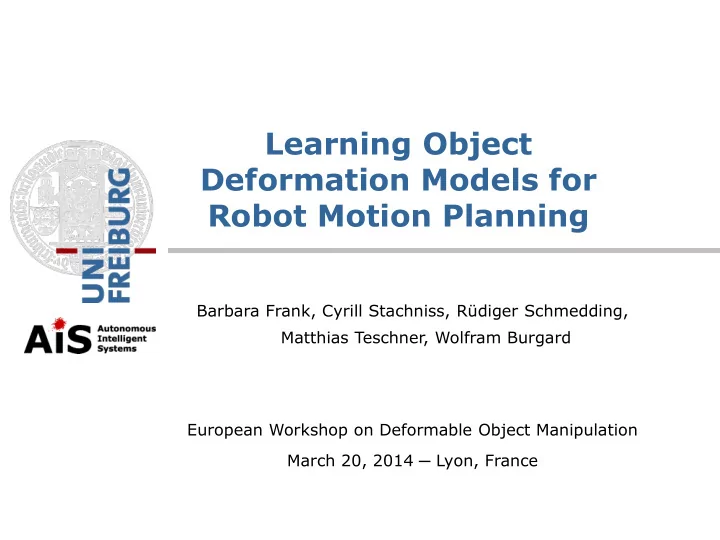

Learning Object Deformation Models for Robot Motion Planning Barbara Frank, Cyrill Stachniss, Rüdiger Schmedding, Matthias Teschner, Wolfram Burgard European Workshop on Deformable Object Manipulation March 20, 2014 ─ Lyon, France 1
Motivation Real environments contain deformable objects such as plants or curtains So far: robots ignore or avoid such obstacles This work: considers the deformation properties of obstacles when planning robot motions 2
Motivation ─ Example 3
Key Questions How soft is this? How can a robot learn about the deformation properties of objects? efficiently consider object deformations Can I during planning? pass through? successfully navigate among deformable objects? 4
Key Contributions Parameter estimation of deformable objects with a manipulation robot Efficient approximation of object deformation cost functions for planning Applications to different real robots 5
Planning with Deformation Costs offline online Learn object deformation model Generate training examples using simulations Train GP to predict cost Roadmap cost by GP regression variance mean training Efficient planner data that trades off motion- and deformation costs Construct roadmap 6
Deformation Simulation Dynamic simulation Collision handling Time integration Finite element model Assumption: linearly elastic, isotropic, homogeneous material Young’s Poisson’s modulus ratio Hooke’s law: linear relation between stress and strain DefcolStudio - Heidelberger et al. / Teschner et al. 7
Geometric Models for Simulation 3D volumetric representation Register point clouds from different view points into a consistent surface mesh Compute a tetrahedral mesh from the surface mesh 8
Acquisition of Deformation Data Weak force Strong force Interaction with Measurement: deformable object Point cloud Applied force Contact point 9
Parameter Estimation Comparison of observed and simulated deformation Scanned surface Error function: distance between registered surfaces Simulated surface Registered surfaces RPROP to optimize Young’s modulus and Poisson’s ratio Point wise error 10
Results: Learned Model - Teddy Estimated parameters: Residual MSE: 11
Evaluation of Learned Models 12
Our Approach to Efficient Motion Planning Sample a subset of possible motions and simulate deformations before planning Estimate the deformation costs of new motions by Gaussian process regression Planning framework: Probabilistic Roadmaps (PRM) 13
Gaussian Processes (GPs) GPs are a framework for non-parametric regression Model the data points (here deformation costs) as jointly Gaussian Predictive model for an input trajectory: Provides a mean and a predictive variance A covariance function models the variance influence of the data points on the query point mean training data 14
Gaussian Processes (GPs) Neural network covariance function … the covariance function requires hyperparameters Learning the hyperparameters by maximizing the likelihood of the training data Popular: maximization via gradient methods Problem: significant cost of learning the GP from data 15
Problem Decomposition We need many samples to accurately approximate the deformation costs Problem: GP learning has cubic runtime complexity in the number of samples due to matrix inversion Local Approximation Store all samples in a KD-tree for efficient nearest neighbor queries Select only trajectory samples that are “close” to build the GP 16
Results: Deformation Cost Prediction Comparison: GP-regression vs. baseline 17
Results: Statistical Evaluation 18
Planning for Manipulators in 3D 3D-model for Experimental setup – roadmap generation deformable foam mat and planning 19
Example Planning Task Ignore deformable Consider obstacles Our planner: obstacles: shortest as rigid: no path minimize trade-off path between motion and deformation costs 20
Robot Navigation in 2D Experimental 3D-deformation 2D-gridmap + setup – Robot in model for curtain position a corridor with generation of for roadmap curtains samples generation 21
Example Planning Task Our planner optimizes the trade-off between travel costs and object deformations During path execution: sensor-based collision avoidance for non- deformable objects 22
Related Work Deformation models Co-rotational FEM: Müller and Gross (2004) FE for surgical simulations: Picinbono et al. (2001) Parameter estimation Inverse FE Methods: Kauer et al. (2002), Becker and Teschner (2007) With robots: Lang et al. (2002), Boonvisut et al. (2012) 23
Related Work Robot motion planning Deformable robots: Kavraki et al. (1998), Bayazit et al. (2002) Surgical tools: Gayle et al. (2005), Alterovitz et al. (2009) Completely deformable environments: Rodriguez et al. (2006) Pre-computations for deformable robots: Mahoney et al. (2010) Model-predictive control: Jain et al. (2013) 24
Conclusions Learning deformation models with a manipulation robot for simulation and path planning Motion planning system that considers object deformations Object deformation cost functions based on Gaussian process regression speed up planning Probabilistic approach to collision avoidance that distinguishes between deformable and non- deformable obstacles 25
Thanks for Your Attention! 26
Recommend
More recommend